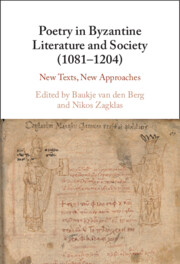Book contents
- Frontmatter
- Dedication
- Contents
- List of Figures
- List of Tables
- List of Contributors
- Introduction: Poetry in Byzantine Literature and Society (1081–1204)
- Part I Poetry and Twelfth-Century Literary Culture
- Part II Poetry and the School
- 5 The Didactic Poetry of Niketas of Herakleia and the Use of Verse in Byzantine Teaching Practice
- 6 Teaching Grammar through Poetry: Tzetzes’ Scholia on the Carmina Iliaca in Context
- 7 Of Mice and Cat: The Katomyomachia as Drama, Parody, School Text and Animal Tale
- 8 On the Roses: Reflections on a Neglected Poem by Nicholas Kallikles (Carm. 29 Romano)
- Part III Poetry, Patronage and Power
- Part IV New Texts, New Interpretations
- Index
5 - The Didactic Poetry of Niketas of Herakleia and the Use of Verse in Byzantine Teaching Practice
from Part II - Poetry and the School
Published online by Cambridge University Press: 17 October 2024
- Frontmatter
- Dedication
- Contents
- List of Figures
- List of Tables
- List of Contributors
- Introduction: Poetry in Byzantine Literature and Society (1081–1204)
- Part I Poetry and Twelfth-Century Literary Culture
- Part II Poetry and the School
- 5 The Didactic Poetry of Niketas of Herakleia and the Use of Verse in Byzantine Teaching Practice
- 6 Teaching Grammar through Poetry: Tzetzes’ Scholia on the Carmina Iliaca in Context
- 7 Of Mice and Cat: The Katomyomachia as Drama, Parody, School Text and Animal Tale
- 8 On the Roses: Reflections on a Neglected Poem by Nicholas Kallikles (Carm. 29 Romano)
- Part III Poetry, Patronage and Power
- Part IV New Texts, New Interpretations
- Index
Summary
The didactic poems of Niketas of Herakleia chiefly concern grammar and are written in various metres, all of them accentual, even including hymnographic metres. Rather than being mere reformulations of existing grammatical knowledge, the poems urge us to consider questions related to contemporary teaching practices. How does verse help to transmit knowledge, and which roles do accentual rhythm and musical heirmos play in this process? Issues of performance, audience and patronage are of undeniable importance for this question. The poems reflect a lively (sometimes unruly) classroom situation and an equally lively competition between teachers in Constantinople. Especially Niketas’ remarks on schedography reflect this competitive teaching field. Thus, the poems of this versatile author may explain why grammar became in the twelfth century an object to be reflected upon, reformulated, debated and even aestheticized. The chapter also situates Niketas in the literary tradition of didactic poetry. How does he, as a poet, at the same time represent himself as an able teacher and expert? And how does he combine poetic form and avowedly dry subject matter?
Keywords
- Type
- Chapter
- Information
- Poetry in Byzantine Literature and Society (1081-1204)New Texts, New Approaches, pp. 139 - 160Publisher: Cambridge University PressPrint publication year: 2024

